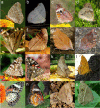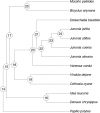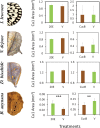Origin of the mechanism of phenotypic plasticity in satyrid butterfly eyespots
- PMID: 32041684
- PMCID: PMC7012602
- DOI: 10.7554/eLife.49544
Origin of the mechanism of phenotypic plasticity in satyrid butterfly eyespots
Abstract
Plasticity is often regarded as a derived adaptation to help organisms survive in variable but predictable environments, however, we currently lack a rigorous, mechanistic examination of how plasticity evolves in a large comparative framework. Here, we show that phenotypic plasticity in eyespot size in response to environmental temperature observed in Bicyclus anynana satyrid butterflies is a complex derived adaptation of this lineage. By reconstructing the evolution of known physiological and molecular components of eyespot size plasticity in a comparative framework, we showed that 20E titer plasticity in response to temperature is a pre-adaptation shared by all butterfly species examined, whereas expression of EcR in eyespot centers, and eyespot sensitivity to 20E, are both derived traits found only in a subset of species with eyespots.
Keywords: 20E; developmental biology; ecdysone; evolutionary biology; eyespot size; lepidoptera; phenotypic plasticity; seasonal polyphenism.
Plain language summary
A well-known family of butterflies have circular patterns on their wings that look like eyes. These eye-like markings help deflect predators away from the butterfly’s body so they attack the outer edges of their wings. However, in certain seasons, such as the dry season in Africa, the best way for this family to survive is by not drawing any attention to their bodies. Thus, butterflies born during this season shrink the size of their eyespots so they can hide among the dry leaves. How this family of butterflies are able to change the size of these eye-like spots has only been studied in the species Bicyclus anynana. During development low temperatures, which signify the beginning of the dry season, reduce the amount of a hormone called 20E circulating in the blood of this species. This changes the behavior of hormone-sensitive cells in the eyespots making them smaller in size. But it remains unclear how B. anynana evolved this remarkable tactic and whether its relatives have similar abilities. Now, Bhardwaj et al. show that B. anynana is the only one of its relatives that can amend the size of its eyespots in response to temperature changes. In the experiments, 13 different species of butterflies, mostly from the family that has eyespots, were developed under two different temperatures. Low temperatures caused 20E hormone levels to decrease in all 13 species. However, most of these species did not develop smaller eyespots in response to this temperature change. This includes species that are known to have larger and smaller eyespots depending on the season. Like B. anynana, four of the species studied have receptors for the 20E hormone at the center of their eyespots. However, changing 20E hormone levels in these species did not reduce eyespot size. These results show that although temperature changes alter hormone levels in a number of species, only B. anynana have taken advantage of this mechanism to regulate eyespot size. In addition, Bhardwaj et al. found that this unique mechanism evolved from several genetic changes over millions of years. Other species likely use other environmental cues to trigger seasonal changes in the size of their eyespots.
© 2020, Bhardwaj et al.
Conflict of interest statement
SB, LJ, MW, JO, HN, AM No competing interests declared
Figures










Similar articles
-
Differential Expression of Ecdysone Receptor Leads to Variation in Phenotypic Plasticity across Serial Homologs.PLoS Genet. 2015 Sep 25;11(9):e1005529. doi: 10.1371/journal.pgen.1005529. eCollection 2015. PLoS Genet. 2015. PMID: 26405828 Free PMC article.
-
Eyespots deflect predator attack increasing fitness and promoting the evolution of phenotypic plasticity.Proc Biol Sci. 2015 Jan 7;282(1798):20141531. doi: 10.1098/rspb.2014.1531. Proc Biol Sci. 2015. PMID: 25392465 Free PMC article.
-
Does predation maintain eyespot plasticity in Bicyclus anynana?Proc Biol Sci. 2004 Feb 7;271(1536):279-83. doi: 10.1098/rspb.2003.2571. Proc Biol Sci. 2004. PMID: 15058439 Free PMC article.
-
Butterfly eyespot patterns and how evolutionary tinkering yields diversity.Novartis Found Symp. 2007;284:90-101; discussion 101-15. doi: 10.1002/9780470319390.ch6. Novartis Found Symp. 2007. PMID: 17710849 Review.
-
Seasonal plasticity: how do butterfly wing pattern traits evolve environmental responsiveness?Curr Opin Genet Dev. 2021 Aug;69:82-87. doi: 10.1016/j.gde.2021.02.009. Epub 2021 Mar 17. Curr Opin Genet Dev. 2021. PMID: 33740694 Review.
Cited by
-
Developmental Plasticity in Butterfly Eyespot Mutants: Variation in Thermal Reaction Norms Across Genotypes and Pigmentation Traits.Insects. 2022 Oct 31;13(11):1000. doi: 10.3390/insects13111000. Insects. 2022. PMID: 36354827 Free PMC article.
-
Distal-less and spalt are distal organisers of pierid wing patterns.Evodevo. 2022 Jun 3;13(1):12. doi: 10.1186/s13227-022-00197-2. Evodevo. 2022. PMID: 35659745 Free PMC article.
-
Miocene Climate and Habitat Change Drove Diversification in Bicyclus, Africa's Largest Radiation of Satyrine Butterflies.Syst Biol. 2022 Apr 19;71(3):570-588. doi: 10.1093/sysbio/syab066. Syst Biol. 2022. PMID: 34363477 Free PMC article.
-
Getting the metabolites right.Elife. 2021 Jun 15;10:e70149. doi: 10.7554/eLife.70149. Elife. 2021. PMID: 34128463 Free PMC article.
-
Eyespot variation and field temperature in the Meadow Brown butterfly.Ecol Evol. 2024 Jan 17;14(1):e10842. doi: 10.1002/ece3.10842. eCollection 2024 Jan. Ecol Evol. 2024. PMID: 38235407 Free PMC article.
References
-
- Bhardwaj S, Prudic KL, Bear A, Gupta MD, Wasik BR, Tong X, Cheong WF, Wenk MR, Monteiro A. Sex differences in 20-hydroxyecdysone hormone levels control sexual dimorphism in Bicyclus anynana wing patterns. Molecular Biology and Evolution. 2017;35:462–472. doi: 10.1093/molbev/msx301. - DOI - PMC - PubMed
-
- Bradshaw AD. Evolutionary Significance of Phenotypic Plasticity in Plants. In: Caspari EW, Thoday JM, editors. Advances in Genetics. Academic Press; 1965. pp. 115–155.
-
- Brakefield PM. Tropical dry and wet season polyphenism in the butterfly Melanitis leda (Satyrinae): Phenotypic plasticity and climatic correlates. Biological Journal of the Linnean Society. 1987;31:175–191. doi: 10.1111/j.1095-8312.1987.tb01988.x. - DOI
-
- Brakefield PM, Reitsma N. Phenotypic plasticity, seasonal climate and the population biology of Bicyclus butterflies (Satyridae) in malawi. Ecological Entomology. 1991;16:291–303. doi: 10.1111/j.1365-2311.1991.tb00220.x. - DOI
Publication types
MeSH terms
Substances
Grants and funding
LinkOut - more resources
Full Text Sources

